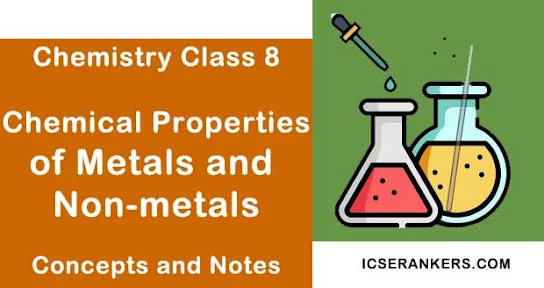Chemical Properties of Metals and Non-metals- Chemistry Guide for Class 8
Information about Chemical Properties of Metals and Non-metals
Title | Chemical Properties of Metals and Non-metals |
Class | Class 8 |
Subject | Class 8 Chemistry |
Topics Covered |
|
Chemical Properties of Metals
Chemical Properties Metals and non-metals differ from each other in their chemical properties also. Let us compare the chemical properties of metals with those of non-metals.
- Reaction with Oxygen
- Reaction with Water
- Reaction with Acids
- Reaction with Alkalies
1. Reaction with Oxygen
Activity 1

Hold a magnesium ribbon with a pair of tongs and ignite it. Magnesium ribbon burns with a bright white light and forms a white powder. The white powder formed is magnesium oxide.
Collect this white powder and dissolve it in water. Dip a strip of red litmus paper in this solution. The red litmus turns blue, indicating that the solution is alkaline. This happens because magensium oxide dissolves in water to form magnesium hydroxide (which is an alkali and (hence) turns red litmus blue).
2MgO (s) + H2O (l) → 2Mg(OH)2 (aq)
- This activity shows that metals react with oxygen to form metallic oxides which are basic in nature. Potassium (K), sodium (Na) and calcium (Ca) are highly reactive metals. They react with the oxygen present in the air, even at room temperature, to form their respective oxides.
Activity 2
Take a small piece of charcoal (a form of carbon) in a deflagrating spoon and ignite it. Put the spoon in a gas jar and cover it with a lid. Remove the spoon from the jar after sometime. Add some water in the jar and cover it again. Mix the contents in the gas jar by shaking it well. Pour the solution in a watch glass and put a strip of blue litmus paper in it. The blue litmus turns red indicating that the solution is acidic. This happens because charcoal (carbon) burns, in presence of oxygen, to form carbon dioxide gas which dissolves in water to form an acid (carbonic acid).
The acid, thus, formed turns blue litmus red.
- This activity shows that non-metals can react with oxygen to form non-metallic oxides which are acidic in nature.
2. Reaction with Water
Activity 3
Take a piece of magnesium ribbon. Clean its surface by rubbing it with a sand paper to remove the layer of its oxide. Put it in a boiling tube; half fill the tube with water. Invert another boiling tube over the mouth of the first boiling tube and gently warm the lower tube over the flame of a bunsen burner (as shown in the figure).
You will observe the evolution of a gas in the form of bubbles. Remove the burner. Carefully bring a burning splinter near the mouth of the upper (inverted) boiling tube. It burns with a crackling sound. This happens because magnesium reacts with water on heating and liberates hydrogen gas which burns with a popping sound.
- This activity shows that some metals can react with water to liberate hydrogen gas.
- Metals differ in their reactivity towards water. For example, sodium and potassium metals reacts very vigorously with water; this reaction gives out so much heat that the hydrogen evolved catches fire. Therefore, these metals are stored under kerosene, or paraffin wax.
- Magnesium does not react with cold water but reacts on heating.
- Zinc reacts with boiling water and iron reacts with steam, indicating that it is very much less reactive.
- Metals like copper, silver, gold, platinum and mercury do not react with water at all.
- Non-metals do not react with water. Therefore, some reactive non-metals are stored in water to prevent their reaction with air.
- For example, phosphorus is kept in water to prevent its contact with air; it catches fire on reaction with air.
3. Reaction with Acids
Activity 8
Take some iron nails and clean their surface by rubbing them with sand paper. Put them in a test tube and then add some dilute hydrochloric acid to the tube. Invert another test tube over the mouth of the first test tube. You will observe the evolution of a gas in the form of bubbles. Carefully bring a burning splinter near the mouth of the inverted test tube. It burns with a popping sound which shows the evolution of hydrogen. Repeat the activity by taking magnesium ribbon and zinc granules; allow them to react with other acids like dilute sulphuric acid.
Compare the observations. Hydrogen gas is released as per the following reactions:
- This activity shows that most metals react with dilute acids to liberate hydrogen gas and form metal salts.
- Some metals, like copper and lead, do not react with dilute hydrochloric acid. They react with sulphuric acid and nitric acid but they do not liberate hydrogen gas.
- Metals, like gold and platinum, do not react with dilute acids.
- Non-metals generally do not react with acids.
- Some non-metals, like sulphur and phosphorus, react with hot concentrated sulphuric acid, or nitric acid, but they do not liberate hydrogen gas.
4. Reaction with Alkalies
Most metals do not react with alkalis. Aluminium and zinc can, however, react with sodium hydroxide, or potassium hydroxide, to form their salts and liberate hydrogen gas.
Some Important Points
- Aluminium cookers are anodised from inside so that in the pressure of air and water, a protective , layer of Al2O3 gets formed there. This layer then prevents further oxidation of aluminium.
- Certain food stuffs like citrus fruits, curd, pickles, tamarind, etc., contain acid. They should not be stored in utensils made of iron, copper or aluminium as the acid present in the food stuff reacts , with the metal and forms compounds which may be toxic.









